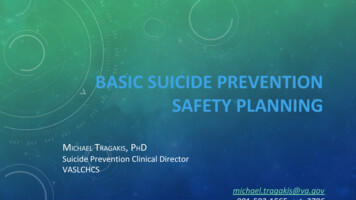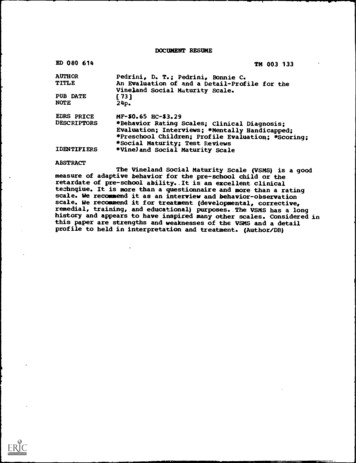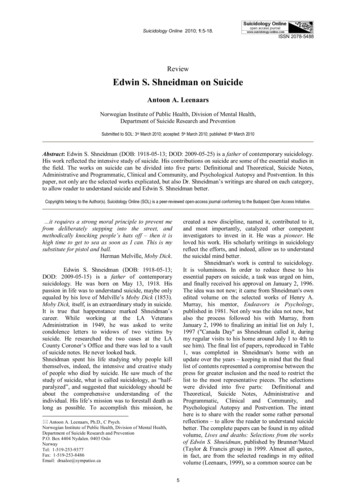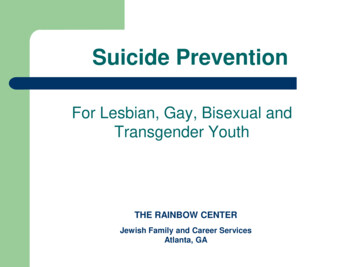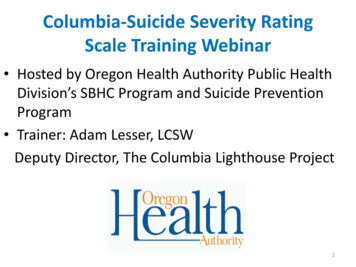
Transcription
Columbia-Suicide Severity RatingScale Training Webinar Hosted by Oregon Health Authority Public HealthDivision’s SBHC Program and Suicide PreventionProgram Trainer: Adam Lesser, LCSWDeputy Director, The Columbia Lighthouse Project1
Suicide in OregonAccess OHA Data Dashboard and Suicide Map Tool /InjuryFatalityData/Pages/index.aspx In 2016, 771 Oregon residentsdied by suicide. 98 of these suicides occurredamong Oregon youth aged 10-24. Suicide is the 2nd leading cause ofdeath among Oregonians aged 1024 years and has been rising since2011. Male youth are 4X more likely todie by suicide than female youth.
Simulation for Health Care Professionals 20-30 minute online learning experience. Awards .75 CEUs for physicians, nurses, socialworkers, and school psychologists. Promotes integration of behavioral health in theprimary care setting. Includes Virtual Patient role-play conversation. Incorporates practice using motivationalinterviewing techniques. 2016 Kognito. All rightsreserved
Learning ObjectivesAfter completing the simulations, users will be able to: Recognize the importance of mental health as partof the role of primary care. Build rapport with patients using motivationalinterviewing tactics. Broach the topic of mental health and correctcommon misconceptions. Demonstrate appropriate ways to ask a patientabout suicidal ideation. Take appropriate steps for referral and follow up. 2016 Kognito. All rightsreserved
Conversation Broach topic of mental health and normalizemental health concerns. Engage Justin in discussion of his mental healthand factors that may be contributing to hisheadaches. Uncover thoughts of suicide, assess risk. Motivate inclusion of parents. 2016 Kognito. All rightsreserved
Accessing the Simulationswww.kognito.com/oregon
Identify Yourself:SBHC staff select Primary Care ProfessionalED StaffPrimary CareProfessional
Provide Detailed Information
On March 12, they are holding 3 trainings: QPR-T: Suicide Risk Assessment and Management Training suicide to Hope training (which is considered the next step for those who have taken ASIST and want to learn moreabout ongoing suicide care) Connect: Suicide Postvention Training (understanding how postvention is prevention).The conference will be March 13-14, and Dr. Sally Spencer-Thomas and Craig Miller will be speaking. Conference tracksinclude: loss and attempt survivors; suicide safer care/systems of care, community suicide prevention, andyouth/education.For more information including the agenda and to register, cide-prevention-conference/9
Oregon Zero Suicide Academy: Sept. 18-19, 2018Suicide Prevention Healthcare Leader Forum will take place on March 14 from 1-2:30pmFeatured Speakers: Zero Suicide faculty member Becky Stoll from Centerstone. One of the nation’s largestnot-for-profit providers of community-based behavioral health care, Centerstone hastracked significant reductions of suicides within their system since they beganimplementing Zero Suicide. Jan Ulrich from the Zero Suicide Initiative will provide an overview of the Zero SuicideAcademy including information about who is eligible to attend the Academy, what theapplication process entails, and what organizations can gain from participating.Please register for Zero Suicide Healthcare Leader Forum 51147562097665
Meghan CraneZero Suicide ProgramCoordinatorOregon Health Authority971-673-1023meghan.crane@state.or.us11
Identification, Triage andMonitoring Using The ColumbiaSuicide Severity Rating ScaleIncreasing Precision, Improving Care Delivery andRedirecting Scarce ResourcesAdam Lesser, LCSWDeputy Director
March 6, 201813Before We Begin Suicide is very personal Many of us are survivors, who miss ourclients, friends or relatives Some may be attempt survivors You shouldn’t hold yourself responsible forsomething you didn’t do/say in the pastbased on what you will learn todayPlease take care of yourself during and after this training
March 6, 2018Suicide is a Global Public Health Crisis,Yet PreventableNearly 1 million People Die From SuicideAround the World Each Year14
March 6, 201815More Deaths Than Natural Disasters,War and Homicide Combined
March 6, 201816Suicide Kills More People than CarCrashes“the under-recognized publichealth crisis of suicide”Thomas Insel, Director of NIMH
March 6, 201817Suicide Touches Everyone135 People Are Affected for Every Death
March 6, 201818Suicide is the #1 Killer of Teenage Girls Across the Globe2nd Leading Cause of Death Among 13-17, 20-36 in the US,60% Rate Increase in 8-12 since 2012
March 6, 201819Suicide Ideation and Attempts AreUnbelievably Common IN YOUR AVERAGE HIGH SCHOOLERS 8% attempted in the past year 17% seriously considered itWithin any typical classroom,it is likely that three students(one boy and two girls) have attemptedsuicide in the past year.
March 6, 201820Relationship to School Violence(Safe Schools Initiative, 2002) 78% of attackers exhibited a history of suicide attemptsor suicidal thoughts prior to their attack 27% reported suicide as a motive in their attack- a “suicide in disguise” 60% had a documented history of extreme depressionor desperationand yet, only 34% of attackers had received a mentalhealth evaluation and just 17% had been diagnosed
March 6, 201821Pyramid of Suicidal Behaviors ency Room405,300Visits forAttempts*Emergency Room Visits cide Attempts**2,700,000Made a2,700,000suicide plan**Made a Suicide **SeriouslyConsideredSuicide**Source: * National Center for Injury Prevention and Control, Centers for Disease Control and Prevention. (2015). Web-based Injury Statistics Query andReporting System (WISQARS). Available from: www.cdc.gov/injury/wisqars/index.html.**Substance Abuse and Mental Health Services Administration, Results from the 2015 National Survey on Drug Use and Health, 2015.
March 6, 201822Any Kind of Medical Illness fromAsthma to Cancer25.5% have ideation8.9% make an attemptCancer patients - ideation 17.7%independent of depressionIf you have one of the following disorders (high blood pressure,heart attack/stroke, cancer, epilepsy, arthritis, chronic headache,chronic pain, respiratory conditions) you are:– 30-160% more likely to have suicidal thoughts– 40-90% more likely to have an attempt
March 6, 201823A Crisis in Every Sector of Society Need to Screen and Care for the CaretakersCorrectionsFirst Responders Doctors A leading cause of death of lawenforcement officers alongside car crashesIn 2012, almost as many died by suicide aswere killed in the line of dutyThe rate of police suicide is comparable tothe US Army RatesIn 2014, 104 firefighters in the UnitedStates died by suicide, only 87 were killedin the line of duty
March 6, 201824Breaking But Not Surprising News: LargePortion of Overdoses Are SuicidesDesperatelySelf-Medicatingin lieu of propertreatment
March 6, 201825Alarming Perspective:Life Expectancy DecreasingOnly DevelopedNation in theWorld
March 6, 201826Rural Areas: One of Our GreatestChallenges Highest rates of suicide Populations spread out acrossgreat distances Less consistent access tomedical and mental healthcare Closest physicians may beseveral hours away andoverburdened High rates of gun ownership(Miller et al., 2013)
March 6, 201827Data on 2011-2015 Suicides in States with the Highest andLowest Rates of Gun Ownershiphigh189 million56%low189 million20%ratiomalefirearm suicidesnonfirearm malefirearm suicidesnonfirearm suicidetotal301534956510335358639219.01.01.7person yearspercent of households with gunsStates with the highest percentage of gun owners include: Wyoming, Montana, Idaho, Mississippi, Vermont, Alaska,Arkansas, W. Virginia, S. Dakota, Tennessee, Maine, Alabama, Utah, Kentucky and Louisiana. States with the lowestpercentage of gun owners include: Hawaii, Massachusetts, Rhode Island, New Jersey and New York
March 6, 201828Oregon Suicide Facts 2016 - 11th highest rate in U.S.1 in 4 suicides in Oregon are VeteransOver 80% of gun deaths in Oregon are suicidesEviction/loss of home was a factor associated with199 deaths by suicide (7%) between 2009 and 2012201510501999 2000 2001 2002 2003 2004 2005 2006 2007 2008 2009 2010 2011 2012 2013 2014 2015 2016OregonUnited States
March 6, 201829Oregon Methods of SuicideMechanism of injury in suicides by sex, Oregon 2016MethodFirearmHanging / suffocationPoisoningFallAll 049190Source: WISQARS, CDC%31283225Total4141841181815772%54241522
March 6, 201830Suicide Rates by County2003-2012
March 6, 2018312015-16 SWS57,000 students php?year 2015
March 6, 201832Depression: Most Debilitating Disease in theWorld Depression will be the world’s mostburdensome disease by the year2030 (WHO, 2008) Depression is already the mostburdensome disease in middle andhigh income countries (WHO, 2008) Depression is the #1 cause of work relatedabsence and costs US workplaces an estimated 23billion annually in lost productivity from just thosedays missed
March 6, 201833Unfortunately, People Who NeedTreatment Do Not Get It! Most people with mental health issues are not suicidal but90% of individuals who die by suicide have untreatedmental illness (60% depression) Under-treatment of mental illness is pervasive– 50-75% of those in need receive no treatment orinadequate treatment (Alonso et al., 2007; Wang et al., 2005)– 70% of children and teens with depression gountreated– 80% of adolescents and college students who die bysuicide never received any consistent treatment prior totheir death
March 6, 2018MYTHS ABOUT SUICIDE34
March 6, 201835“If someone is really suicidal, they are probably going tokill themselves at some point no matter what you do”This is FALSE!– Multiple studies have found that 90% of attemptsurvivors including those who make highly lethalattempts do not go on to die by suicide– Most people are suicidal only for a short amount oftime– So, helping someone through a suicidal crisis can belife-saving
March 6, 201836“Asking a depressed person about suicide may putthe idea in their heads”This is FALSE!– Does not suggest suicide, or make it morelikely– Open discussion is more likely to beexperienced as relief than intrusion– Risk is in not asking when appropriate
March 6, 201837“Someone making suicidal threats won’t reallydo it, they are just looking for attention”This is FALSE!– Those who talk about suicide or expressthoughts about wanting to die, are at risk forsuicide and need your attention– Take all threats of suicide seriously. Even if youthink they are just “crying for help”—a cry forhelp, is a cry for help—so help
March 6, 201838“There’s no point in asking about suicidalthoughts if someone is going to do it they won’ttell you”This is FALSE!– Many will tell clinician when asked, though mightnot have volunteered it – often a relief– Ambivalence is characteristic in 95%– Contradictory statements/behavior common– 80% give some kind of hints/warnings to friendsor family, even if don’t tell clinician
March 6, 201839People Want to Be Asked Makes a pact with himself “If one person asks me Goes to Golden Gate BridgeApproached by a German tourist“I instantly realized that everything in my life thatI’d thought was unfixable was totally fixable –except for having just jumped.” “Most people considering suicide want someoneto save them. What we need is a culture in whichno one is afraid to ask.”
March 6, 201840“If you stop someone from killing themselvesone way, they’ll probably find another”This is FALSE! “Means safety” – reducing a suicidal person’s access tohighly lethal means - has strong evidence as effectivesuicide prevention strategy
March 6, 201841Means Safety WorksVery Little Method Substitution in all cases United Kingdom 1958 – replacing coal gas with natural gas– suicide rate by carbon monoxide poisoning was cut by 1/3New Zealand 1992 – stricter gun licensing and required lockedstorage reduced gun suicide in youth by 66%England 1998 – introduced individual blister packaging forTylenol 44% reduction in Tylenol overdose over next 11 yearsSwitzerland 2003- Firearm suicides in men 18-43 decreased by27% as a direct result of reducing size of Army by 50% thuslyreducing the number of soldiers storing guns at homeIsraeli military 2006 - restricted gun access for off-duty soldiers,suicide rate dropped 40% in military
March 6, 201842Ashley Williams - MarylandI had PPD with my second child. Things got bad. Very bad. I'm notsure when I started planning suicide, but at the time, it felt likesomething normal. Like going grocery shopping.I needed something reliable because I couldn't botch this andthen be a medical burden to my family. I don't have a gun. Findinga manner that was fast and reliable took a long time and it wasduring that time that I recognized what was happening and gothelp.That was years ago. I'm fine now, but I would most likely not behere to write this had there been a gun in my home at that time
March 6, 201843Working With the FirearmCommunity An estimated 55 Million Americans own afirearm CDC reports 22,018 firearm suicides in2015 (50% of total suicides) 2/3 of all gun deaths are suicidesUses for C-SSRS In gun/sporting shops At firing ranges In firearm safety training At firearm tradeshows
March 6, 2018SUICIDE IS PREVENTABLE AND EFFORTSDEPEND FIRST UPON ACCURATEIDENTIFICATION44
March 6, 201845The Problem and Consequences of Not HavingCommon DefinitionsField of medicine challenged bylack of clarity about suicidalbehavior and absence of welldefined terminology (researchand clinical)Negative implications onappropriate management ofsuicide - if suicidal behavior andideation cannot be properlyidentified, it cannot be properlyunderstood, managed or treatedin any population or diagnosisMany different terms for thesame behaviorFurthermore, comparisonacross epidemiological datasets is compromised
March 6, 201846How to Fix the Problem Columbia - Suicide Severity Rating ScalePosner, K.; Brent, D.; Lucas, C.; Gould, M.; Stanley, B.; Brown, G.; Zelazny, J.; Fisher, P.; Burke, A.; Oquendo, M.; Mann, J. Developed in NIMH effort to uniquelyaddress need for summary measure –1st scale to assess full range ofideation and behavior, severity,density, track changeMany leading experts - collaborationwith Beck’s group10s of millions administrationsAvailable in over 100 languagesVery brief administration time Deemed “most” evidencedsupportedExcellent acceptance in practiceby patients and providersAge: suitable across thelifespan for use with adults,adolescents, and youngchildren.Special Populations: indicatedfor cognitively impaired (e.g.Alzheimer's, Autism)
March 6, 201847Adopted by CDC:Importance of a Common Language“The C-SSRS is changing the paradigm in suicide riskassessment in the US and worldwide” – Alex CrosbyAlso from CDC:“Unacceptable Terms” Completed suicide Failed attempt Parasuicide Successful suicide Suicidality Nonfatal suicide Suicide gesture Manipulative act Suicide threat
March 6, 2018Public-Private Partnership: NationalAction Alliance – Toolkit for Zero Suicide NY- Eval of recent suicides allsame picture: No good riskassessment, no safety plan,no warm hand-off C-SSRS and Safety Planningto be used in training all staffto screen *all patients*statewide48
March 6, 201849The Centerstone Care Pathway:“With so many patients its like mining for gold and theColumbia is the sifter” Screen everyone at every service delivery point Follow-up/Weekly appts, Means restriction on the other end If pt is DO NOT SHOW, attempt and document phone-call within 2hours If unable to contact referred to Follow-Up specialist who attemptsto contact for 3 days for brief telephone risk assessment andencouragement to re-engage, name populates in purple in EHR,enter Suicide Pathway and Crisis line which never shuts downuntil they are tracked down
March 6, 201850Everyone, Everywhere Can Ask 812 nurses trained - 99% reliability independent of mental health trainingand education Strong inter-rater reliability among non-clinicians in juvenile justice-(Kerr, et. al. 2014) First RespondersJuvenile JusticeCorrectionsHostage NegotiatorsParentsYouthCrisis Response TeamsHotlinesIn schools:–––––TeachersSafety OfficersCoachesRoad patrolBus drivers Peer to PeerHospitalsPediatriciansVAClergyChild Protective ServicesOfficers Standing OvernightIn behavioral healthcare:––––––Peer counselorsParaprofessionalsReceptionists – “get to hear allthe casual conversations staffdon’t”NursesNurses’ aidesCustodial/Janitorial Staff
March 6, 201851ACE Cards in Developmentfor use across all military branches
March 6, 201852ACE Cards in the communityIn English and Spanish versions
March 6, 201853Must Go Beyond the Medical Model:Marines Reduce Suicide by 22%Undersecretary of DefenseUrgent MemoTotal force roll-out In the hands of whole communityALL support workers: lawyers, financial aid counselors, chaplains
March 6, 201854Military Chaplains Peer-to-Peerhttps://youtu.be/MfBXroY5doo
March 6, 201855Linking of Systems:Organizational Vision/Top-Down ModelsDepartment Health & Mental HealthProvider By ProviderChildProtectiveServicesFirstRespondersand CrisisLinesAll ServicesBetween ServicesHospitalsLinking SystemsInpt Bridge OutptAll Systems of CareHomelessServicesPrimary CarePrecision of communication: enablesquicker response to those who need itSchoolsJustice/LawyersLawEnforcement
March 6, 201856Since Asking With An Everyone,Everywhere Approach Utah AchievesDecrease in SuicideReversed an alarming increasingtrend over the past 10 yearsTotal Number of Suicides 2010-2014Total Number of SuicidesA former Nevada Senator grappledwith her state’s suicide rate andlooked to progress made in Utah forhope, saying :“Utah recently reversed an upwardtrend in suicides and experts areciting the implementation of the 0200100020102011Year
March 6, 201857Need to Ask: Screen and MonitorLike We Do for Blood Pressure 45% of all people and 58% of olderadults who die by suicide see theirprimary care doctor in the monthbefore they die (Luoma et al., 2002) Many adolescent attempters in the ERdo not present for psychiatric reasons(King et al., 2009) 25% of all people who die by suicideare seen in ER in past 12 months fornon-psychiatric reasons (Gairin et al., 2003)A GREAT OPPORTUNITY FORPRVENTION !If we ask we can find them!!
March 6, 201858Screening Programs are Successful High school screening identified 69% of the students with significantmental health issues compared to clinical professionals who identifiedonly 48%. When both screening and professional referral were used82% were identified (Scott et al., 2009) College Screening Project - data suggest that screening brings high-riskstudents into treatment– Only 1 suicide in 4 years post-screening vs. 3 suicides in 4 years prescreening program (Haas et al., 2008) Meta-analysis concluded that screening results in lower suicide ratesin adults (Mann et al., JAMA 2005) Elderly primary care screenings - 118% increase in rates of detectionand diagnosis of depression (Callahan et al., 1996)
March 6, 201859First-Ever Universal Screening uses the CSSRS at Parkland Memorial Hospital andFinds only 1.8% of 100,000 Patients Screening all patient encounters: “We believe that it’s important to screen everyonebecause some of this risk may go undetected in a patient who presents fortreatment of non-psychiatric symptoms.” (Dr. Kimberly Roaten, Department ofPsychiatry)Specialized algorithm in electronic health record that triggers appropriate clinicalintervention based on patient answers to C-SSRS questionsDedicated Resources including 12 psychiatric social workers and a behavioral healthteam“When suicidal behaviors are detected early, lives can be saved . even within the first fewdays of implementing the screening program, we were able to intervene with patients athigh risk.”Dr. Celeste Johnson, Director of Nursing
March 6, 201860Joint Commission promotes the C-SSRS“The research shows thatthis tool will helporganizations focus on folkswho are at highest risk.”- Anne Bauer, MD, field director,Accreditation and CertificationOperations, The Joint Commission.[Hospitals and health care systems]have either developed somethingthemselves or they’re using apiecemeal approach, with differenttools in different departments: Whatmay appear to be a person at risk inone area may not appear to be at riskin another. When the ED is askingtheir set of questions, and then thesocial worker asks another set, thenthe psychiatrist asks another, you’rereducing the signal strength. You’renot honing in on the needle in thehaystack.
March 6, 2018TRAINING ON THE C-SSRS61
March 6, 201862C-SSRS is Simply .Ideation SeverityIdeation IntensityBehaviorsLethality of Actual Suicide Attempts
March 6, 201863C-SSRS is Simply .Assessment of Suicidal Ideation and Suicidal Behavior Ideation Severity - 1-5 rating, of increasing severity from awish to die to an active thought of killing oneself with planand intent (Full and Screener C-SSRS) Ideation Intensity – 5 intensity items (Full C-SSRS Only) Behaviors - All relevant behaviors assessed and all itemsinclude definitions for each term and standardized questionsfor each category are included to guide the interviewer forfacilitating improved identification (Full and Screener C-SSRS) Lethality of Actual Suicide Attempts (Full C-SSRS Only)
March 6, 2018C-SSRS is a Semi-structured Interview Questions are provided as helpful tools– it is not required to ask any or allquestions – just enough to get theappropriate answer Most important: gather enough clinicalinformation to determine whether tocall something suicidal or not64
March 6, 201865Multiple Sources :Don’t Have to Rely on Individual’s Report Most of time person will give you relevant info,but when indicated . Allows for utilization of multiple sources ofinformation– Any source of information that gets you the mostclinically meaningful response (subject, familymembers/caregivers, records) Very helpful for children and adolescents whomay not give same info as parents or othercaregivers
March 6, 201866Examples – A peer comes to your office and reports that his friend postedon Instagram that he wants to die.– A loved one brings a family member into the ER. The patientdenies suicidal thoughts, but the family member shares withyou that the he has been talking about suicide for the pasttwo weeks and wrote a note yesterday and that is why he ishere in the ER.– Client is at intake for outpatient services and denies lifetimesuicidal ideation and behavior but medical record sent frominpatient hospital indicates admission for recent attempt.
March 6, 2018SUICIDAL IDEATION67
March 6, 201868This is theFullC-SSRSIdeationPageTypicalAdministrationTime Few Minutes68
March 6, 201869C-SSRS Screener Ideation QuestionsPsychosis: Auditory hallucinations count as suicidal ideation
March 6, 201870Each Type of Ideation Severity Confers IncreasinglyGreater Risk
March 6, 201871Ideation Severity Demohttp://youtu.be/2kpB3Tq2mgU
March 6, 201872Method or Plan?The patient reported that he first started thinkingabout killing himself when he was 12. He thoughtabout how easy it would be to pretend to fall infront of a bus before it was able to stop so that itwould look like an accident. Although he thoughtabout it often, he said he did not have the courageto do it.1. Suicidal ideation with plan (Question 5)2. Suicidal ideation with method (Question 3)
March 6, 201873Intensity of IdeationOnce most severe type of ideation isdetermined, a few follow-up questions areasked– Frequency– Duration– Controllability– Deterrents– Reasons for ideation (stop the pain ormake something else happen)
March 6, 201874
March 6, 201875
March 6, 201876
March 6, 201877
March 6, 201878
March 6, 201879
March 6, 201880Clinical GuidanceFor Intensity of Ideation, risk is greater when:–––––Thoughts are more frequentThoughts are of longer durationThoughts are less controllableFewer deterrents to acting on thoughtsStopping the pain is the reason Gives you a 2-25 score that will help informclinical judgment about risk Duration found to be most predictive inadolescents (King, 2009)
March 6, 2018SUICIDAL BEHAVIOR81
March 6, 201882FullC-SSRSSuicidalBehaviorSection
March 6, 201883Data Supports Importance of Full Range:All Lifetime Suicidal Behaviors Predict Suicidal BehaviorBehaviorreported atbaselinePatients rospectivelyreportingsuicidal behaviorOdds ratio ofprospective suicidalbehavior report(95% CI;***p-values .001)Actual Attempt522 (85.6 %)88 (14.4 %)4.56 (3.40 – 6.11)***InteruptedAttempt349 (82.7 %)73 (17.3 %)5.28 (3.88 – 7.18)***Aborted Attempt461 (84.7 %)83 (15.3 %)4.75 (3.53 – 6.40)***PreparatoryBehavior177 (81.2 %)41 (18.8 %)4.92 (3.38 – 7.16)***A person reporting any one of the lifetime behaviors at baseline is 5X morelikely to prospectively report a behavior during subsequent follow-up
March 6, 201884Suicide Attempt DefinitionA self-injurious act undertaken with at leastsome intent to die, as a result of the act There does not have to be any injury or harm, justthe potential for injury or harm (e.g., gun failing tofire) Any “non-zero” intent to die – does not have to be100% Intent and behavior must be linked
March 6, 201885Inferring IntentImportance ofInference Intent can sometimes be inferred clinically from thebehavior or circumstances– e.g., if someone denies intent to die, but theythought that what they did could be lethal, intentcan be inferred– “Clinically impressive” circumstances; highly lethalact where no other intent but suicide can beinferred (e.g., gunshot to head, jumping fromwindow of a high floor/story, setting self on fire,or taking 200 pills)
March 6, 201886Suicide Attempt A suicide attempt begins with the first pillswallowed or scratch with a knife Questions:– Have you made a suicide attempt?– Have you done anything to harm yourself?– Have you done anything dangerous where youcould have died?
March 6, 201887As Opposed ToNon-suicidal Self-injurious Behavior Engaging in behavior PURELY (100%) forreasons other than to end one’s life:– Either to affect: Internal state (feel better, relieve pain etc.) “self-mutilation”- and/or External circumstances (get sympathy,attention, make angry, etc.)
March 6, 201888Suicide Attempt? Yes or NoThe patient wanted to escape from her mother’shome. She researched lethal doses of ibuprofen.She took 6 ibuprofen pills and said she felt certainfrom her research that this amount was not enoughto kill her. She stated she did not want to die, only toescape from her mother’s home. She was taken tothe emergency room where her stomach waspumped and she was admitted to a psychiatric ward.1. Yes2. No3. Not enough information
March 6, 201889Suicide Attempt? Yes or NoYoung woman, following a fight with her boyfriend,felt like she wanted to die, impulsively took akitchen knife and made a superficial scratch to herwrist; before she actually punctured the skin orbled, however, she changed her mind and stopped.1. Yes2. No3. Not enough information
March 6, 201890Suicide Attempt? Yes or NoPatient was feeling ignored. She went into thefamily kitchen where mother and sister were talking.She took a knife out of the drawer and made a cuton her arm. She denied that she wanted to die at all(“not even a little”) but just wanted them to payattention to her.1. Yes2. No3. Not enough information
March 6, 201891Suicide Attempt? Yes or NoThe patient cut her wrists after an argument withher boyfriend.1. Yes2. No3. Not enough information
March 6, 201892Suicide Attempt? Yes or NoHad a big fight with her ex-husband about her stepson.Took 15-20 imipramine tablets and went to bed. Sleptall night and until 4-5 pm the next day. States shecouldn’t stand up or walk. Called EMS – taken to theER – drank charcoal and admitted to hospital. Unableto verbalize clear intent, but states she was well awareof the dangers of TCA overdose and the potential fordeath.1. Yes2. No3. Not enough information
March 6, 201893Suicidal Behavior – Actual Attempts May helpto inferintentImportant:Shows you did theappropriateassessment anddecided it should notbe called suicidal
March 6, 201894Other Suicidal Behaviors .Interrupted Attempt When person starts to take steps to end their life butsomeone or something stops them Examples– Bottle of pills or gun in hand but someone grabs it– On ledge poised to jump Question:– Has there been a time when you started to do something toend your life but someone or something stopped you beforeyou actually did anything?
March 6, 201895Aborted/Self-Interrupted Attempt When person begins to take steps towards making a suicideattempt, but stops themselves before they actually haveengaged in any self-destructive behavior Examples:– Man plans to drive his car off the road at high speed at a chosendestination. On the way to the destination, he changes his mind andreturns home– Man walks up to the roof to jump, but changes his mind and turns around– She has gun in her hand, but then puts it down Question:– Has there been a time when you started to do something to end yourlife but you stopped yourse
Please register for Zero Suicide Healthcare Leader Forum at: . 90% of individuals who die by suicide have untreated . think they are just “crying for help”—a cry for help, is a cry for help—so help. Ma

